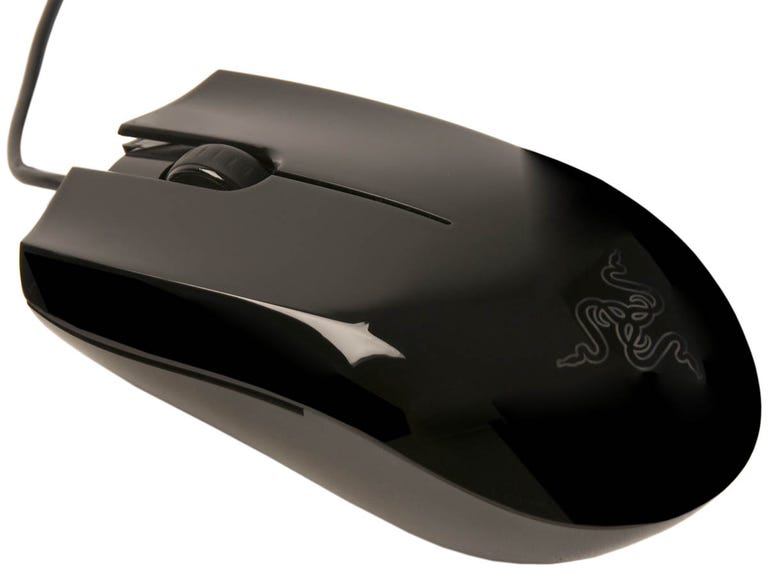 Why You Can Trust CNET
Why You Can Trust CNET Razer Abyssus Mirror Special Edition review: Razer Abyssus Mirror Special Edition
The Abyssus slithers a different path from the rest of Razer's snake-named gaming mice -- it's the cheapest in the range. It still offers a 3,500dpi sensor for highly accurate performance, but it's cut down on some of the features that adorn its more expensive broodmates
Sensor sensibility
The Abyssus boasts a 3,500dpi infrared sensor, the same one you'd find on the more expensive DeathAdder model. The higher the dpi (dots per inch) count on the sensor, the more precisely your movements will be represented on screen. This sensor will be more than precise enough for most gamers, and we found that under ideal conditions mouse movement was indeed very sharp.
The Good
The Bad
The Bottom Line
We stress 'under ideal conditions' because the Abyssus is something of a prima donna. Testing on a range of mousing surfaces, we found the Abyssus to be extremely picky about the ones it deigned to work on. It won't play nicely with standard desktops, so you'll want to invest in a proper gaming mouse mat to get the best performance -- preferably a soft fabric mat that affords a good deal of grip.

That 3,500dpi sensor has a very low lift-off distance, which means it'll stop working if it moves up off the mousing service even slightly. While many gamers appreciate a low lift-off distance (especially if you're the type of player who regularly lifts your mouse to quickly reposition), we found that because the Abyssus itself is extremely light, it frequently lifted-off within our grip. Our grasp on the mouse itself caused a disconnect between sensor and surface, particularly when drawing the cursor down.
Misplaced
The Abyssus features built-in switches to toggle dpi and polling rate. Unfortunately, those switches are located on the underside of the mouse, meaning you won't be able to go for them mid-game.
That's a real kick in the WASD, as many gamers appreciate the ability to adjust mouse sensitivity on the fly -- imagine decreasing sensitivity as you zoom in with a sniper-rifle, for example, making your shots more accurate. Many competing mice offer extra buttons on a mouse's surface devoted to dpi switching, or customisable keys for macros and other functions.
The ability to switch polling rate (how often the mouse communicates its co-ordinates to the computer per second) is a cool addition, though we can't really imagine anyone opting for the bog standard 125Hz over the higher 1,000Hz option.
Although we bemoan the lack of additional buttons, the standard three we do have are impressive. The left and right click pads are massive, and shaped to accommodate your entire finger. They're not too sensitive, but when you do go for the click they feel springy and responsive.
Rock and scroll
The real star, however, is the scroll wheel. Some of Razer's previous efforts have underwhelmed in the scroll department, but there's no such disappointment here. Scrolling feels delightfully solid, and clicking with the scroll wheel is as springy and comfortable as the two click buttons. We're slightly disappointed to find there's no left and right scroll click, again something you'd find in many other gaming mice.
Connection is handled via a 2m USB cable thankfully mounted quite high on the Abyssus' front, so you won't find the cable dragging and skewing your mouse movements. Still, many competing gaming mice offer wireless connectivity.
The Abyssus will work straight out of the box, but if you fancy tinkering with the advanced settings, software is available for download from the Razer Web site, where you can further adjust the sensitivity, and customise button assignments. The Abyssus is also suitable for lefties, thanks to its perfectly symmetrical frame.
Conclusion
There are a number of features missing from the Abyssus that you'd find in other gaming mice, such as on the fly DPI switching or additional buttons for macros, left and right scroll-wheel clicks or wireless connectivity. What you're left with is a back-to-basics, no frills gaming mouse, and while this is Razer's cheapest offering yet, it's not the kind of functionality we'd associate with £35 worth of tech. If you can stretch to a few pounds more, check out the fully featured Microsoft SideWinder X8.
Edited by Nick Hide


